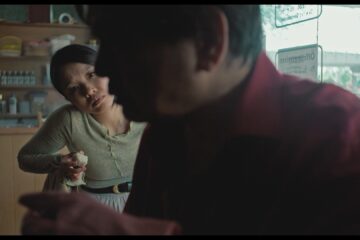State of Statelessness is an anthology film consisting of four short films made by Tibetan filmmakers living in exile. It is a collective effort of exploring the themes of statelessness and migration embedded within everyday life of the Tibetan diaspora. In this interview, Tenzin Tsetan Choklay (producer and co-director) talks about the structure and mission of the Drung Tibetan Filmmakers Collective, as well as the film’s journey from its initial seed to full fruition. Tsering Tashi Gyalthang (co-director) reflects on his experiences of directing the first segment, sharing both onscreen meditations on environmental issues and offscreen moments of inspiration with the filmmaking team.
Interviewees: Tenzin Tsetan Choklay, Producer, co-director of State of Statelessness; Tsering Tashi Gyalthang, co-director of State of Statelessness
Interviewer: Xiangu Qi
The project was produced by the Drung Tibetan Filmmakers Collective based in the Tibetan diaspora community of Dharamsala. Could you share some behind-the-scenes insights into how the collective operates—particularly in terms of collaboration, fundraising, and international distribution?
Tenzin: Drung is a young collective I co-founded with fellow filmmakers Tenzin Kalden and Sonam Tseten, with the goal of advancing storytelling within Tibetan exile communities. At its core, the collective functions as a mutual support system – providing a space for filmmakers to share resources, exchange expertise, and help one another bring projects to life. Beyond producing films, we are committed to nurturing a wider community of Tibetan storytellers through workshops, mentorships, screenings, and educational initiatives. Everyone in the collective works on a voluntary basis, which means that any funding we receive goes directly into supporting projects and programs.
For State of Statelessness, we were fortunate to have the support of our executive producer, Yodon Thonden, with whom I had previously collaborated, and our partner The Tibet Fund, which for the first time stepped into film production. Beyond this, most of our work is sustained by small but meaningful contributions from Tibetan community members around the world – acts of solidarity that keep our projects alive. In terms of international reach, our approach has been organic: rather than pursuing traditional distribution models, we’ve relied on networks of film festivals, cultural organizations, and diaspora communities to create visibility for our work. This grassroots mode of operation reflects both our limitations and our strengths—it keeps us closely connected to the communities we represent, while also allowing our stories to travel across borders.
State of Statelessness is a transborder, transnational, and transcultural production. How did the project evolve from its initial concept into a completed film?
Tenzin: Drung is a filmmakers’ collective rooted in the exile Tibetan community of Dharamshala (in India). The seed of this project was planted during conversations with the late Tibetan filmmaker Pema Tseden, who directed Snow Leopard (2023), Balloon (2019), Jinpa (2018), and Tharlo (2015) while he was in New York. Through those exchanges, as well as through ongoing dialogue with Tibetans living inside occupied Tibet, we came to recognize a profound curiosity they hold about life in exile – particularly in India. Tibetans inside Tibet often wonder how those of us in exile live our everyday lives: what challenges we face, how we sustain our identity in foreign lands, and how we continue to navigate being Tibetan in countries that are not our own. Their questions span from the intimate to the expansive: what dreams we carry, what work sustains us, what food we eat, what music and films we enjoy, what clothes we wear, and even what keeps us awake at night.
We also came to the realization that, despite having preserved our Tibetan-ness over decades of exile, we have not successfully shared these lived experiences with our brothers and sisters inside Tibet – neither through books, music, art, nor cinema. This realization gave rise to the idea of creating a film that would offer a window into our lives in exile, and in doing so, begin to build a bridge between the two worlds of Tibetans inside Tibet and those living in exile.
The film brings together four filmmaking teams in India, Vietnam, and the United States. Could you describe how these teams collaborated throughout the production process? How were the segments integrated into a cohesive whole?
Tenzin: With the core idea of telling stories about the lived experiences of Tibetans in exile, our collective reached out to Tibetan filmmakers working in different parts of the world. Since we are only a handful at the moment, we initially brought together five filmmakers, each tasked with creating a story around statelessness and migration within Tibetan exile communities. One of them, a female filmmaker, eventually withdrew to pursue her own film, leaving four segments that ultimately shaped State of Statelessness.
From the outset, we deliberately kept the directive open-ended, giving each filmmaker full creative freedom to pursue their vision. Each was provided with a very modest budget and a fixed timeline—two of the biggest constraints of the production. Despite these limitations, Drung, as a collective, remained actively engaged, supporting each project from the script stage to final post-production and helping filmmakers navigate the challenges of working under such restrictions. Initially, we explored ways of imposing a more structured framework to tie the stories together. But when all the scripts came in, we discovered a natural progression and resonance among them, allowing the anthology to form an organic cohesion without heavy-handed editorial intervention. Throughout the process, regular Zoom calls and meetings across time zones ensured that collaboration remained smooth, even across continents and despite limited resources.
As a multilingual film, how did the filmmaking teams approach the casting process across different linguistic and cultural contexts (Tibetan, Vietnamese, English, and Hindi)?
Tenzin: We gave each of the commissioned filmmakers complete freedom to handle casting in the way that best suited their stories. This allowed the process to reflect the diversity of the contexts in which the films were made. The result was inspired choices – from talented Vietnamese actors who brought depth to their roles, to Tibetan performers whose lived experiences informed their portrayals.
We also remain deeply indebted to our non-Tibetan collaborators, particularly the Indian technicians and artists in Mumbai – such as Rajesh Thanickan our Post-Production Producer, Bridge Postworks, Aural Mayhem Studio and Harkat Studios—whose expertise and dedication were instrumental in bringing the project to life. Their contributions underscore the truly transnational and transcultural spirit of the film.
The opening segment, “Where the River Ends,” centers on a Tibetan diasporic man’s storytelling about the Mekong River, linking the place where he was born (Tibet) and the place where his daughter was born (Vietnam). What inspired you to explore this theme, and how did it take shape during the filmmaking process?
Tsering: I’ve lived in Vietnam for twenty years and have always felt a deep connection to the Mekong River; it felt like seeing a part of my own homeland. Over the years, the river has become a symbol of my own identity and my attachment to my homeland. When this project came along, it was the perfect time to explore these themes. I wanted to meditate on what it means to be a stateless person, both physically and metaphysically. I also wanted to explore what this means for the next generation, children of the world who are born into a different culture from their parents. The entire production, from writing to shooting and editing, became a personal meditation on these subjects.
The soundtrack features several Tibetan songs. What aspects of these musical pieces were important for you to highlight, and how do they contribute to the film’s thematic resonance?
Tsering: The film’s music is integral to its message. The opening and closing songs were performed by my friend, Tenzin Choegyal, who played Tenzin, the main character of the film, and composed the main theme.
The opening song, “I Wish I Were a Bird”, is a cover of a song by Jampa Tsering, a singer whose work was banned by the Chinese government. This choice is significant because it perfectly captures the deep sense of longing felt by Tenzin. The song symbolizes the yearning for a home and a life that are no longer accessible. It is an impossible wish to return home, like wishing for the Mekong River to flow upwards to Tibet.
The closing song’s lyrics, “Oh moon, rising in the east, please don’t set in the west. Please stay in the middle,” are the film’s core message. They poetically summarize the struggle of the Tibetan diaspora, the desire to hold on to one’s roots and cultural identity while living in a new land. It’s a plea for a balance between the past and the present, a yearning for stability that reflects the stateless experience.
The use of these specific songs, with their histories and meaningful lyrics, elevates the film to a profound meditation on identity, displacement, and the preservation of culture. The music provides a layer of emotional depth that words of the characters alone cannot.
The narrative carries an ecocritical dimension – especially with the reference to a dam that blocks the river. What led you to include this detail, and how does it relate to your exploration of Tibetan diasporic identity?
Tsering: The detail about the dam is based on my own conversations with locals in the Mekong Delta. It’s a real-world issue. China’s extensive damming of the Mekong and four other major rivers originating in Tibet threatens the ecosystems and livelihoods of tens of millions of people downstream across Asia. I felt it was impossible to discuss the Mekong and Tibet without including this critical ecological concern, which directly affects people in Vietnam.
The scene with the Vietnamese aunt, played by the great comedian Nguyễn Thị Phi Phụng, was specifically written to convey a sense of solidarity. She deliberately mentions the Chinese dams, knowing Tenzin’s personal connection to the river and the situation in his homeland. This shows that his suffering is not an isolated experience. The scene highlights how everything is connected, weaving Tenzin’s personal loss into a larger narrative of shared struggle. It’s a subtle but crucial moment that underscores the film’s theme of interconnectedness.
It is often said that working with children and animals poses unique challenges in filmmaking. What was your experience working with the young actress who played the daughter? Are there any memorable or unexpected moments from that part of the production?
Tsering: Working with the young actress, Phương Linh, who played the daughter, was a truly wonderful experience. Having made films about children before, I’ve learned that it’s often more effective to work with a child’s natural way of being rather than trying to force them into a rigid performance. Phương Linh was incredibly patient and brilliant, and she was truly the heart of the film.
The production faced significant challenges. We had only two days to shoot in the Mekong Delta with minimal time for rehearsal, and to make things more difficult, we were hit with heavy rainstorms on both days. It was a physically demanding situation, as we pushed through the rain and mud. While the crew was concerned for Phương Linh, she was all smiles and genuinely enjoyed every moment. Her way of being inspired everyone to laugh and enjoy through it all.
State of Statelessness will be shown on Viet Film Fest 2025’s virtual platform and will be available there from October 4-19.


